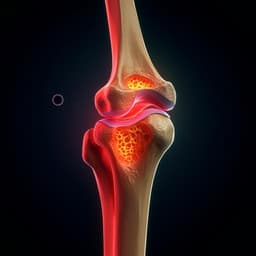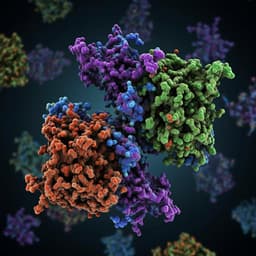
Physics
A particle-field approach bridges phase separation and collective motion in active matter
R. Großmann, I. S. Aranson, et al.
This groundbreaking research by Robert Großmann, Igor S. Aranson, and Fernando Peruani unveils a theoretical framework that revolutionizes our understanding of active matter by connecting phase separation and collective motion. The study illustrates the impact of varying particle shapes on motility-induced phase separation and enables a fascinating insight into order emergence in complex systems.
~3 min • Beginner • English
Introduction
The study investigates how particle shape and anisotropic interactions determine collective behaviors in active matter. Two pillars of active matter theory are highlighted: (i) motility-induced phase separation (MIPS) in self-propelled discs driven by self-propulsion and isotropic repulsion, and (ii) orientational symmetry breaking with collective motion due to velocity alignment. While MIPS has strong theoretical support, experimental realizations of pure MIPS in discs are scarce and torques often interrupt MIPS. Conversely, rod-shaped particles show rich phenomena such as clustering, banding, mesoscale turbulence, and chaos, often attributed to shape-induced alignment. The research question is whether a unified framework can bridge scalar active matter (discs, density-only descriptions) and vectorial active matter (rods, orientational order) and explain when MIPS breaks down and when orientational order (polar or nematic) emerges. The purpose is to develop a particle-field model that is analytically tractable yet realistic, to elucidate how anisotropic repulsion and self-propulsion generate nonequilibrium stresses that destabilize MIPS and promote ordering. The study is important for understanding diverse systems such as bacterial colonies, biomimetic assays, and granular rods, and for designing active materials where particle shape, rigidity, and activity interplay.
Literature Review
Prior work established MIPS for self-propelled discs due to speed reduction upon collisions and isotropic repulsion, with effective scalar field theories for density. Experiments and theory indicate torques and hydrodynamics can suppress MIPS, with boundary conditions and geometry playing crucial roles. Velocity alignment and collective motion arise via inelastic collisions, hydrodynamic, electric, or magnetic interactions, and notably via anisotropic steric repulsion of elongated bodies. Numerical studies of rods revealed mesoscale turbulence, bands, wall accumulation, and phase diagrams dependent on rigidity and density. Cell-based models of soft deformable particles or phase fields differ fundamentally due to activity-shape coupling, lacking passive-rod-like isotropic–nematic transitions. Hydrodynamic theories and kinetic derivations exist primarily for models with prescribed alignment rules; Onsager-type arguments apply in the passive, large aspect ratio limit. Recent work quantified effective transport in rods and suggested torques suppress MIPS. Reports also indicate interrupted MIPS in aligning active colloids and coexisting ordered states in motility assays with flexible filaments. These strands motivate a framework explicitly integrating particle shape and steric interactions while remaining analytically accessible.
Methodology
Modeling approach: Each particle is represented by an anisotropic Gaussian field ψ_i(r) with principal axes l_∥ and l_⊥, controlling shape anisotropy ε (or aspect ratio φ = l_∥/l_⊥). Overlap of two fields is computed analytically to define a repulsive pair interaction energy U_ij(I_ij), yielding force f_2 and torque m_2 by gradients with respect to position and orientation. The torque contains two contributions: (i) a classical nematic alignment term b sin[2(φ−φ′)], and (ii) a novel nematic collision-avoidance term a sin[2(φ−α)] that couples orientation to relative position (α = arg Δr), favoring orientations perpendicular to the center-to-center axis to minimize overlap.
Dynamics: Overdamped Langevin equations govern particle positions and orientations:
ẋ_i = v_0 e_∥(φ_i) + μ_t[φ_i] Σ_j f_2(x_i−x_j, φ_i, φ_j) + η_t(t),
φ̇_i = μ_r Σ_j m_2(x_i−x_j, φ_i, φ_j) + √(2D_r) ξ_r(t).
Translational noise is anisotropic: η_t(t) = √(2D_∥) e_∥ ξ_∥ + √(2D_⊥) e_⊥ ξ_⊥. Interactions, diffusion, and friction are nematically symmetric; self-propulsion v_0 e_∥ breaks inversion symmetry.
Kinetic theory and coarse graining: From the N-particle Fokker–Planck equation, the one-particle distribution P(r,φ,t) is derived, with force and torque functionals depending on the pair correlation function g_2. Moment expansions yield hydrodynamic equations for density ρ and polar order p, and involve the nematic tensor Q. For small ε, average force and torque due to density gradients are computed: F ≈ −ζ_0 κ ε[φ] ρ and M ≈ −ε ζ_0 κ (cosφ ∂_x − sinφ ∂_y) ρ, indicating density-dependent speed reduction and torque away from high-density regions. Coarse-grained equations include ∂_t ρ ≈ −∇·(v(ρ) ρ) + D_0 Δρ with v(ρ) = v_0 − μ ζ_0 κ ρ, and ∂_t p ≈ −∇·[(v(ρ)/2) p] + v_p + D_0 Δp, plus anisotropic nonlinear flows ∝ ρ ε Π ∇ρ coupling density gradients to order parameters.
Linear stability and MIPS criterion: Adiabatic elimination near the homogeneous state yields an effective diffusion coefficient and a necessary condition for MIPS; anisotropy shifts the spinodal to higher v_0, suppressing MIPS.
Transport coefficients for order: Hydrodynamic coefficients governing local growth of polar (σ_ρ or α_p) and nematic (σ_η or α_n) order are expressed as integrals over effective torque m_2 g_2. Mean-field (g_2≈1) predicts no polar order; correlations renormalize interactions and can generate effective polar alignment.
Numerical simulations: Langevin dynamics integrated via stochastic Euler; interactions truncated beyond several Gaussian widths. Intrinsic scales chosen to nondimensionalize equations (area fixed; κ=1). Phase behavior explored by varying aspect ratio and v_0. Pair-correlation functions g_2 measured in co-moving frames to quantify collision kinetics (front–back asymmetry; enhanced parallel alignment).
Key Findings
- Unified particle-field framework reproduces MIPS for discs and predicts ordering phenomena for rods, connecting scalar and vectorial active matter within one model.
- Breakdown of MIPS with slight anisotropy: Aggregates observed for discs melt already at aspect ratio l_∥/l_⊥ ≈ 1.0424, drastically reducing density fluctuations and hexatic order. A torque from anisotropic repulsion (nematic collision avoidance) rotates rod orientations away from aggregate boundaries, dissolving the polar boundary layer required to sustain MIPS.
- Necessary condition for MIPS shifts with anisotropy: Linear stability yields a criterion analogous to the disc case but with ε-dependent terms; anisotropy shifts the spinodal to higher v_0, suppressing MIPS. No re-entrant MIPS is observed beyond a critical anisotropy in simulations.
- Emergence of orientational order with increasing anisotropy: After MIPS breakdown, a globally disordered state with local nematic order appears, followed at higher anisotropy by local polar order and formation of large, long-lived polar clusters and bands (often with smectic layering along bands).
- Defects and active stresses: Collisions of polar domains generate half-integer defects (in nematic sense) that are self-motile due to polar energy input, with intermittent creation/annihilation driven by density instabilities.
- Polar–nematic bistability controlled by activity vs. rigidity: For fixed high anisotropy (aspect ratio ≈ 4) and varying v_0, three regimes occur: (a) low v_0: polar clusters (blocking dominates); (c) high v_0: nematic bands (sliding dominates, Vicsek-nematic-like); (b) intermediate v_0: bistable coexistence with stochastic switching of global polar order. Reported coexistence window: 2.37 ≤ v_0 ≤ 2.5 (dimensionless units) with large fluctuations of the polar order parameter.
- Collision kinetics underlies polar order: Pair correlations show enhanced probability of parallel motion of nearby rods and asymmetric excluded volume. The product m_2 g_2 generates effective polar-alignment terms at the mesoscale, allowing σ_ρ>0 and polar order despite purely nematic microscopic interactions. Polar order requires self-propulsion (v_0>0).
- Quantification of density fluctuations and ordering thresholds: Variance of coarse-grained density decreases with anisotropy as MIPS breaks down; local nematic order onsets when σ_η crosses zero, and local polar order when σ_ρ crosses zero (Fig. 6).
Discussion
The framework demonstrates that particle anisotropy and self-propulsion jointly generate nonequilibrium torques and stresses that destabilize MIPS and promote orientational order, addressing how scalar-density descriptions fail for anisotropic active matter once vector/tensor order emerges. Self-propulsion breaks microscopic nematic symmetry, enabling correlations to induce effective polar alignment and macroscopic polar order even with purely nematic steric interactions. The symmetry of ordered states is thus an emergent, dynamical property governed by collision kinetics and whether particles can slide past each other. At high activity, nematic alignment dominates and yields Vicsek-type nematic bands; at low activity/high rigidity, blocking and correlated collisions yield polar clusters with active stresses and smectic layering. These results rationalize experimental observations of interrupted MIPS and coexisting ordered states and provide a bridge between disc-like and rod-like active matter. The analytic coarse-graining links microscopic parameters and pair correlations to hydrodynamic transport coefficients, clarifying mechanisms behind phase stability and order formation.
Conclusion
The study introduces a smooth particle-field model that unifies key phenomena in active matter: it reproduces MIPS for isotropic discs, explains its breakdown with slight anisotropy via a torque dissolving polar boundary layers, and predicts the emergence and coexistence of nematic and polar order in rods. It shows that macroscopic symmetry is not fixed by microscopic interaction symmetry but emerges from collision kinetics modulated by self-propulsion, anisotropy, and rigidity. The framework connects scalar to vectorial active matter, offering insights applicable to bacterial colonies, active filaments, and granular rods. Future directions include deriving g_2 for anisotropic self-propelled objects from first principles, incorporating nonlinear cross-couplings between density, polar and nematic order, assessing thermodynamic-limit behavior (especially of coexistence), integrating hydrodynamic interactions, and extending to disordered environments, polydispersity, and semiflexible filaments.
Limitations
- Mean-field approximations (g_2≈1) cannot capture polar order; effective polar alignment arises only via correlations, requiring measurement or theory of g_2, which is not derived from first principles here.
- The necessary MIPS condition derived is not sufficient; full phase behavior at larger anisotropy is determined numerically.
- Long-range orientational order appears absent in the thermodynamic limit for rods; some reported ordered states (e.g., nematic bands, polar clusters) are system-size dependent and may not persist asymptotically.
- Hydrodynamic interactions are not included; their known impact on alignment and MIPS suppression is deferred to future work.
- For small anisotropy, mobilities and diffusion are simplified to isotropic; simulations truncate interactions beyond several decay lengths.
- Bistability of polar and nematic global order is observed in finite systems; authors do not expect it to remain in the thermodynamic limit due to slow diffusion within nematic bands.
Related Publications
Explore these studies to deepen your understanding of the subject.







